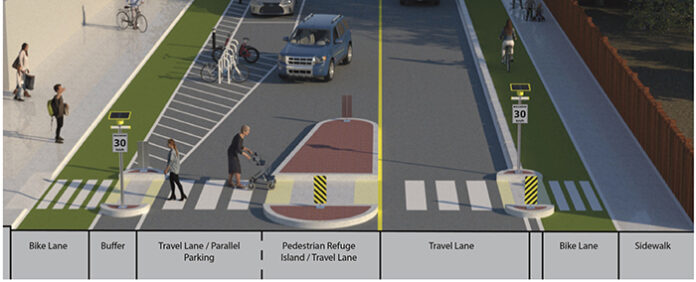Salt Spring’s newest governing body is tackling pedestrian safety in Ganges village — and will be asking the Ministry of Transportation and Infrastructure (MoTI) to help it make several “big moves” recommended by a just-released Active Transportation Network Plan.
Under direction of the former transportation commission — and with the help of funding from a B.C. Active Transportation Network planning grant — Capital Regional District (CRD) senior transportation planner John Hicks and a team from both the CRD and the Watt Consulting Group have delivered a plan focused on making Ganges a more “walkable” community easily accessible by cycling.
This is hardly the first transportation plan for Salt Spring, Hicks reminded Local Community Commission commissioners at their meeting Tuesday, July 18, pointing to one centred on Ganges in 2014 as well as a very recent MoTI study that focused on cycling safety between the island’s ferry terminals. But the commonalities between the studies, along with a seemingly refreshed interest on the part of MoTI to take action on the Salt Spring roads it controls, may present a new opportunity to increase safety and accessibility in the village.
“Anything we do on Salt Spring, as I’m sure you’re acutely aware, requires a lot of collaboration with the Ministry of Transportation,” said Hicks. “And we’ve brought them through this whole process from day one; every piece of this plan has been walked through with them as we’ve advanced it. Every recommendation has been passed through them.”
The plan identifies five so-called “big moves” that can be taken soon, if not right away — defined by planners as lower-cost, high-impact steps that would align not only with the MoTI cycling safety review but with Salt Spring Islanders’ concerns heard during the exhaustive community engagement process.
And for their part, LCC members seemed eager to jump on as many of them as they could, as quickly as possible. Commissioners took action on the first — a recommendation to drop the posted speed limit through Ganges to 30 km/hr from the current limit of 50 — right after the presentation Wednesday, directing staff to draft a letter to MoTI indicating the LCC supported the change, and another to the CRD Board asking it to pass a similar recommendation and send that along to the ministry.
The remaining “big moves” — redesigning of McPhillips Avenue to make it more pedestrian friendly, increasing off-street parking with a few proposed locations, a comprehensive land ownership survey to identify where MoTI land ends and private property begins throughout Ganges, and a pedestrian “island” as part of a traffic-calming redesign at the bottom of Ganges Hill — would take a little more time. But commissioners received the report — which included a cost estimate for all the “big moves,” just over $1.6 million — and asked staff to move forward with exploring funding opportunities for the design work that would enable construction grants, as well as to what extent MoTI might be willing to incorporate the recommendations into its existing plans.
“[MoTI] see it as something very interesting, something new, that is potentially something which could be mirrored in other communities,” said Hicks. “I think there’s probably more of an appetite [there] than in the previous 10 years I’ve been working here on the island.”
Beyond the five “big moves,” the full Active Transportation Network Plan and recommendations can be read here.

